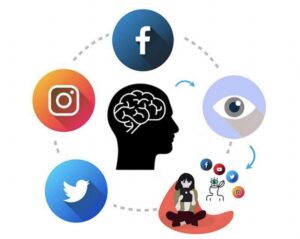Today’s topic is our perceptions that govern our lives and even determine our destiny. We perceive the world according to our life maps in our minds, and we create the perception records in our minds with our records that we hear from many places and people such as parents, teachers, bosses, spouses, lovers, society, etc. and accept without questioning and throw them into the subconscious and what we record through our senses.
In essence, when we look at it, we all live as sleepwalkers. The world that no one sees and perceives is not real and true. Therefore, if there are 8 billion people in the world, there are actually 8 billion different worlds that all these 8 billion people see. In this situation, there is no point in trying to impose our truths on each other. It has not worked so far and it will not work in the future. All we can do is to try to know and understand ourselves, the other person, and life more. Just like in Halil Cibrian’s statement I always repeat, “we came to this world not to be understood, but to UNDERSTAND!”.
If we proceed with deduction again, let’s start with the definition of perception and then move on to its management.
Table of Contents
TogglePerception Management
Perception is our sensory experience of the world around us.
What is Perception Management?
“Perception” can also be defined as “the process by which individuals select, organize and interpret inputs from their senses to give meaning and order to the world around them”.
Factors affecting the perceiver:
Our life maps: Our database is based on our past experiences and knowledge
Motivational state: the needs, values, and desires of the perceiver at the moment of perception
Mood: the perceiver’s emotions at the moment of perception
Factors affecting the target:
Uncertainty: Uncertainty. If uncertainty increases, the perceiver may find it difficult to form an accurate perception.
Social status: A person’s actual or perceived position in society or an organization
Impression management: An attempt to control the perceptions or impressions of others.
Targets use impression management tactics when interacting with perceivers who have power over them. Various impression management tactics include behavioral matching between the target of the perception and the perceiver, self-enhancement (presenting oneself in a positive light), conforming to situational norms, appreciating others, or being consistent.
But is perception more important than reality?
If you can shape the perception of yourself and others, you can bend reality. And that makes you a formidable thought leader. Realism is not exactly the best guide to personal happiness. But if you are aware of and can manage the differences between your inner and outer worlds and the journeys within them, great. In our outer life, it is necessary to manage the perceptions of the people or colleagues working in the business environments we are in and to be “everything with everyone”; while in our inner journey, we need to move forward with the awareness of our own “nothingness” without taking the external person or process too seriously. Because as the saints, masters, and dervishes say, we live among sleeping people. At least thanks to technology, we live among human machines. Therefore, it would not be very wise to expect “consciousness” from people who are not aware of themselves, their self, and their existence. We need to know ourselves, understand life and the meaning of our existence as much as possible, and develop mutual understanding.
And indeed, researchers have found that it is best to be a realistic optimist. It has also been proven that optimists are more successful in life.
Perception Management Examples?
Perception is cognition that processes sensory information. It is the individual’s connection to both the outside world and his or her own body. The following are illustrative examples of perception.
Types of Perception
Visualization | Hear | Touch |
Tactile perception | Taste | Odor |
Time | Essence | Representative |
Body position | Gravity | Velocity, acceleration, and direction |
Balance & movement | Temperature | Internal senses |
Pain | Intuition | Significance |
Social perception |
Visualization
Vision including color perception.
Hearing
The ability to hear sound. Most people can hear sounds between 20 Hz and 20,000 Hz.
Touch
The ability to perceive the physical world through physical contact with it
Tactile Perception
he combination of touch + time so that people can understand the movement of things they touch. For example, the ability to detect the shaking of an airplane in turbulence.
Taste
The ability to perceive the composition of matter, especially food and drink, with the mouth.
Odor
The ability to perceive the composition of the air with the nose. This greatly affects the taste and appears to play a role in memory.
Time
The ability to perceive the composition of time and estimate how much time has passed between events.
Self-identity
The feeling that you exist, a general awareness of your body and mind
Representative
The feeling that you are in control of your body and mind and have a limited ability to influence the outside world
Body position
Awareness of the position of parts of the body. For example, awareness of where your legs are at some point when you are running. This relies on sensations known as the somatosensory system.
Speed, acceleration, and direction
Awareness of the speed and acceleration of the body. For example, a person on an uncontrolled snowboard can feel a significant rate of acceleration. It also relies on the vestibular system.
Balance & Movement
The perception of the stability of the body when moving in space and time. This relies on multiple senses such as vision, somatosensory and vestibular systems.
Temperature
The ability to feel the warmth of parts of your body and things you touch.
Internal Senses
The ability to feel your organs. For example, the ability to feel that you need oxygen and need to breathe or that you need to go to the toilet.
Pain
An unpleasant sensation is provided by the central nervous system that signals problems in the body.
Intuition
The ability to perceive information that does not originate in the conscious mind. Ancient Greek philosophers, including Plato and Socrates, saw it as a kind of connection with universal presence. Modern science tends to see intuition as the product of unconscious thought, though it is not currently better understood.
Specificity
Salience is the ability to automatically detect what might be important in a sea of sensory information. For example, a cyclist picks up the sound of a car behind them out of big city noise.
Social Perception
The ability to perceive social information independently of conscious thought. For example, the ability to intuitively perceive emotions, possibly using cues such as body language and facial expressions.
As a result, we collect a lot of data about ourselves and the outside world through these rich sensors, process this data according to our mental programs, and produce outputs accordingly. These outputs form our reactions to life or the other person. Just like computers. At this point, I say that when we change this program in our minds, our outputs will also change and therefore our lives will change. You are welcome to think about it.
Perception Management and Manipulation
Manipulation is a social influence that aims to change the perceptions, opinions, and behavior of others through various tactics and deception without making them feel it. Manipulation methods create an exploitative, cunning, and deceptive effect in line with the interests of the manipulator.
Unfortunately, the modern world has created a generation that watches, not thinks, researches and questions.
Manipulation techniques:
- Not Allowing the Why Question to be Asked
- Leaning on the Truth: Truth is the Best Defense Against Lying
- Expertise, Reliability, and Reputation: Accredited Knowledge
- Expertise, Reliability, and Reputation: Accredited Knowledge
- Pre-sale: Ploughing the Field: Creating prejudgment.
- Detaching from the Whole: Drowning in the stream: The story of the blind perceiving an elephant
- Repeat: Continuous Repetition
- Processing the information: Adding-Hiding-Highlighting
- Addressing the Emotions Not the Mind: Fear, Anger, Lust
- The Whole World Agrees!
Manipulations are more dangerous than perception management. Unfortunately, perception management and manipulation are often used in today’s media worldwide. I think that the influence of the media on the masses is a kind of syringe effect. They are tools through which the desired dose of vaccine is administered little by little every day. That’s why I have removed all kinds of media from my home for 15 years. I don’t use TV or newspapers. Instead, I only read the necessary news in 10 sentences from the summary mobile news that comes to my mobile phone. That’s enough.
Just as we pay attention to the food we put in our stomachs; I think we should pay even more attention to the food in our minds.
Do not escape from the hunger of your soul by stuffing your body or mind. Remember that societies need herds.
“What man loses by the social contract is his natural freedom and an unlimited right to what he wants and can obtain, and what he gains is social freedom and the ownership of what he has.” – Jean Jacques Rousseau
“The freedom of man is not in being able to do anything he wants, but in not having to do anything he doesn’t want to!” – Jean Jacques Rousseau
How to Manage Perception?
I would like to briefly discuss perception management from two different frameworks, especially individual and corporate.
Individual Perception Management
First, you need to understand yourself and how you are perceived. To understand how others see you, you need to observe yourself accurately.
- Spend some quiet time each day examining who you are and who you are not.
- Ask for informal feedback from trusted friends or colleagues. You may be surprised by how they perceive you. Be aware that they will give subjective opinions based on personal views, so try to remain objective and explore what might have influenced these opinions. Recognize from the outset that most people will not be able to look objectively and that the majority will give feedback from their subjective perspective.
- More formal tools such as psychometric tests or personality inventories can help you to recognize yourself. Feedback from these can be easier to manage as they are objective and involve no third-party relationships.
- 360-degree surveys that gather the views of target audiences both inside and outside the business can help, focusing on behaviors as well as skills. Be aware of the differences between the two. While both can be learned and changed, changing the way you behave often involves changing personality traits and perceptions and is more difficult than acquiring new technical skills.
When reviewing test results, try not to focus only on personal information that feels hurtful. Look for patterns in feedback. Think about when and why. Stress often allows unintentional behavior to surface. It is also possible that you are completely unaware of the behavior that creates the impression you want to change.
Remember that building self-awareness requires courage and commitment, so don’t let yourself become discouraged by what you have learned.
Do’s:
- Increase your self-awareness
- Be aware of your influence on others
- Learn to interpret the verbal and non-verbal signals of others
- Know the impact of stress on you and how it shows up to others.
- Be visible in strategic moments
- Encourage feedback from people you care about without making unreasonable demands
- Let others make their own choices
- Give yourself enough time and make perception management part of your personal development.
- Be consistent, patient, and forgiving
Don’ts:
- Reacting emotionally to the feedback you receive
- Defensive behavior
- being unmotivated
- being caring
- To act aggressively and try too hard too quickly
- wait too much
- Involving others in your views of yourself
- Disturbing people for feedback
- Being political or manipulative in your behavior
In a nutshell, perception management is the ability to create an impression through conscious activity and awareness of other people and the impact of your behavior on them. To be successful, identify your target audience, align their values with yours, adjust your communication style, encourage feedback and be aware of how you are adapting every step of the way.
Corporate Perception Management

Organizations use perception management before major product/strategy launches and following crisis events, as well as in day-to-day internal and external interactions. When we look at successful life-cycle models of organizational development, we see that behind the growth and eventual survival of these successful firms is the effective management of crises or crisis-like events by their business leaders throughout their life cycles.
Organizational perception management involves actions designed and carried out by spokespeople of an organization to influence the target audience’s perceptions of the organization. This definition is based on an understanding of the four unique components of organizational perception management: perceptions of the organization; actions or tactics; organization spokespeople; and organizational audiences. Organizational perceptions are further classified into three main forms: organizational images, organizational reputations, and organizational identities.
At this point, corporate identity studies for external customers, digital marketing, social responsibility projects, and slogans that highlight the institution and/or product gain importance. As for the internal customer, Human Resources activities are necessary. All these studies should be created in a way to create the right perception with the adjectives such as trust/quality/effectiveness/appropriateness etc. in the internal and external customers of the organization itself and/or its product/service. In short, an emotional bond should be established between the customer and the company through perception management.
Determine Your Strategy
Before starting a perception management strategy, identify your goals, how you plan to achieve them, and how you will monitor your progress. Focus initially on changing something that will create a quick win.
That’s why the in organizations the following studies are of great importance:
- Human Resources Management Studies
- Marketing Strategy
- Digital Marketing Strategy
- Export Strategy
Businesses
To obtain the desired behavior and purchasing patterns from consumers, businesses shape public perceptions through marketing and sales activities as mentioned above. Even today, neuromarketing studies are very successful in this regard.
Advertisement
There can be no other form of communication without a perception to manage in terms of advertising and brand image. This certainly emphasizes the importance of brand image. Sometimes managing perception can only mean giving consumers a perception. Advertising adds a positive light to consumer opinions, without even thinking about its message and quality.
Branding and Brand Control/ Brand Management
Companies often use brand management to change a potential customer’s perception of the value of the product. Through positive association, a brand manager can strengthen the company’s marketing and gain brand equity. This is an important step in perception management as it aims to produce the most effective results. Brand management deals with competitors, promotions, costs, and satisfaction to gain the trust of consumers and show positive feedback.
Leadership
People can use perception management as a way to positively develop their leadership abilities. A person’s ability to manage perceptions is what sets great leaders apart from others. What people, your followers, evaluate as your effectiveness and ability as a leader becomes their perception and then becomes reality. Unmanaged perceptions of one’s followers create a reality that is the opposite of what is desired. Perception management is a very difficult task, but it can help us all develop as leaders.
Marketing
The best way for businesses to influence public perceptions is through marketing. To get people to buy products, marketers must create a need and manage public perception so that they feel the product will fulfill that need. This is not the same as manipulation, where businesses create something that people do not need and marketers convince them that they need it. Good perception management benefits the consumer. After all, it fulfills more of their needs and benefits the business because it increases revenues.
In some marketing schemes, marketers create a need that does not exist and then offer to fulfill that need. A good example is credit card companies. Credit card companies, like many other companies, start ostensibly as a convenience to the population. Credit cards offer an alternative payment method to cash or cheques.
Risk management
Future decision-making is an element of business that has a major impact on the future of the company. If the company is too risky, this leads to underperformance and missed opportunities. If the company takes too much risk, there is likely to be a large number of losses. Consequently, if such risk-taking leads to the company’s perception exceeding the limits of logic and reality, the company will most likely fail due to its poor perception. Today, companies cannot afford not to manage perceptions.

Where is Perception Management Used?
Although perception management operations are typically conducted internationally between governments and between governments and citizens, the use of perception management techniques has become part of mainstream information management systems in many ways that do not concern military campaigns or government relations with citizens. Businesses may even contract with other businesses to do perception management on their behalf, or they may do it in-house with their public relations staff.
As a prime example of where perception management is being used, I would cite business organizations. Businesses shape public opinion through perception management to obtain the desired behavior and purchasing patterns from consumers.
Advertising
There can be no other form of communication without a perception to manage in terms of advertising and brand image. This emphasizes the importance of brand image. If a consumer has heard of a brand, he or she can rationalize that the company must spend a fair sum on advertising. If it spends a lot of money on advertising, the company must be reasonably profitable, which means that other consumers must buy the product and be sufficiently satisfied with its performance; therefore, the product must be of reasonable quality. Sometimes managing perception may simply mean giving consumers a perception.
Brand Management
Companies often use brand management to change a potential customer’s perception of the value of the product. Through positive association, a brand manager can strengthen the company’s marketing and build brand equity. This is an important step in perception management as it aims to produce the most effective results. Brand management deals with competitors, promotions, costs, and satisfaction to gain the trust of consumers and show positive feedback.
Leadership
People can use perception management as a way to positively develop their leadership abilities. A person’s ability to manage perceptions sets great leaders apart from others. What people – followers – evaluate as effectiveness and ability as a leader becomes their perception and then becomes a reality. The unmanaged perceptions of one’s followers create a reality that is the opposite of what is desired.
Marketing
The best way for businesses to influence public perceptions is through marketing. To get people to buy products, marketers must identify a need and manage public perception so that they feel the product will fulfill that need.
This is not the same as manipulation, where businesses create something that people do not need and marketers convince them that they need it. Good perception management benefits the consumer. After all, it fulfills more of the customer’s needs and benefits the business because it increases revenues.
Risk management
Future decision-making is a business element that has a major impact on the future of the company. If the company is risk averse, this leads to underperformance and a missed opportunity. If the company takes too much risk, there is likely to be a large number of losses. Consequently, if such risk-taking leads to the company’s perception exceeding the limits of logic and reality, the company will most likely fail due to its poor perceptions. Companies today cannot afford not to manage perceptions.
International communication
The communication gaps that exist in international trade can lead to misunderstandings. Perception management helps to prevent complex emotional features of communication from changing the original interpretation of the message. Perception management also serves to change the original interpretation of the message to avoid complex emotional features in communication.
Perception Management in Social Media
I would like to mention the concept of social customer relationship management in perception management in social media. Although it has been around for many years even in Turkey, I think it is still not understood enough and I would like to share it with you here. The subject of Social CRM (Social Customer Relation Management), i.e. social customer relationship management, is the integration of social media channels into Customer Relationship Management (CRM) platforms. CRM platforms increasingly support social media as well as traditional channels so that customers can interact with businesses through their preferred channels. This means better customer service and more marketing information gathered from customer social media data. Social media connections and the information contained therein are therefore used to collect data about the product you are selling or the customer you want to follow and to accurately manage the perception of your organization or service on social media.

Social CRM programs make it possible for a business to communicate with customers using the channel of their choice, whether by phone, text, chat, email, or social media (e.g. Facebook or Twitter). Thus, through a social CRM system, businesses can collect richer, actionable information from the customer about their company, their brand, and their specific products or services. This collected information also provides data input to UI/UX (user interface/user experience) designers. In this way, designs are developed that will make it even easier for the products sold through digital media to reach the customer and shop on the site.
The best CRM systems can take this dynamic customer profile and use it well for perception management purposes by disseminating this information among different teams, including customer service, marketing, and sales.
Those who wish can access the most successful social CRM applications from the link below:
https://crm.org/crmland/social-crm
Perception Management in Advertisements
In advertising, perception relates to a consumer’s impression of a particular product or service that is not based on facts. For example, an advertisement for soda pop featuring a thin film star drinking the product may distort the consumer’s perception of the brand and how it might look after consuming the product. This perception through advertising works to stimulate further demand for the product. Unlike the actual characteristics of a product that can be identified through research and statistics, the perception of a product can be influenced and be more transient.
Without perception in advertising, businesses may find it difficult to make their products attractive to consumers. Advertising often works by appealing to consumer tastes, desires, fantasies, and wishes. Perception can be an important tool in advertising to make consumers feel that they can be a certain person, look a certain way, or feel a certain emotion when using a particular product. For example, a beer advertisement set on a sunny, tropical beach may make you feel that you can relax and unwind if you drink the beer.
An important element of consumer perception of advertising is exposure. Exposure consists of how often consumers are exposed to a product. Perception is often based on how much people are “exposed” to the adverts around them. For example, if you are not shopping for a house, you may not see adverts for houses on television, billboards, and in magazines. On the other hand, if you are actively looking for a home, you may be more “exposed” when you see home adverts. This influences whether the advert in question catches your attention and enables the next step of perception to take place. That is selective perception.
As I mentioned above, if you are looking for something really important, I recommend that you use the media to do your research and that you separate yourself from newspapers, magazines, television, etc., where information is constantly repeated. Keep them switched off at all times. Listen to music instead.
Frequently Asked Questions About Perception Management
What is Perception Management?
Perception is our sensory experiences about the world around us. “Perception” can also be defined as “the process by which individuals select, organize and interpret inputs from their senses to give meaning and order to the world around them”. The inputs from these senses fall into our subconscious programs and are processed there. After being processed there, compared with our past data, and concluded, it is sent out as output.
How is perception management done?
Perception management tactics are frequently used especially in marketing activities. Slightly more advanced tactics of this nowadays continue to operate under the name of neuromarketing. Perception management is the manipulation tactics applied to the sensory organs where people receive and collect data from outside. It is used extensively in advertisements, marketing, and politics. The aim is to give the person what they need to hear, not the truth. Sometimes this is information, sometimes it is a belief, and sometimes it is a feeling of pleasure. Since the mind is a programmable organ, this is very easy.
If we know it, we can manage it. Normally in the human brain, as long as it does not question under these conditions, the reptile brain decides to buy. But if we start to question, we move the event to our upper brain, the neocortex. Then we decide after comparing it with other data such as judgment, comparison, and questioning whether what we are going to buy is really what we need. That’s when we move the event from the reptilian brain to the upper brain. This is conscious shopping.
Book and Film Recommendations on Perception Management
The Me Century (BBC Documentary)
Psychology of Persuasion (Book)


